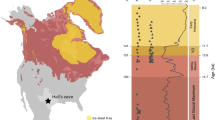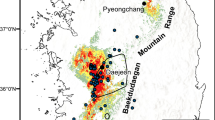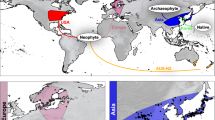Abstract
Climate change in the Arctic is a growing concern for natural resource conservation and management as a result of accelerated warming and associated shifts in the distribution and abundance of northern species. We introduce a predictive framework for assessing the future extent of Arctic tundra and boreal biomes in northern Alaska. We use geo-referenced museum specimens to predict the velocity of distributional change into the next century and compare predicted tundra refugial areas with current land-use. The reliability of predicted distributions, including differences between fundamental and realized niches, for two groups of species is strengthened by fossils and genetic signatures of demographic shifts. Evolutionary responses to environmental change through the late Quaternary are generally consistent with past distribution models. Predicted future refugia overlap managed areas and indicate potential hotspots for tundra diversity. To effectively assess future refugia, variable responses among closely related species to climate change warrants careful consideration of both evolutionary and ecological histories.
This is a preview of subscription content, access via your institution
Access options
Subscribe to this journal
Receive 12 print issues and online access
$209.00 per year
only $17.42 per issue
Buy this article
- Purchase on Springer Link
- Instant access to full article PDF
Prices may be subject to local taxes which are calculated during checkout




Similar content being viewed by others
References
Callaghan, T. V. et al. Biodiversity, distributions and adaptations of Arctic species in the context of environmental change. Ambio 33, 404–417 (2004a).
Callaghan, T. V. et al. Responses to projected changes in climate and UV-B at the species level. Ambio 33, 418–435 (2004b).
IPCC Climate Change 2007: Impacts, Adaptation, and Vulnerability (Cambridge Univ. Press, 2007).
Harris, S. A. Thermal history of the Arctic Ocean environs adjacent to North America during the last 3.5 Ma and a possible mechanism for the cause of the cold events (major glaciations and permafrost events). Prog. Phys. Geog. 29, 218–237 (2005).
MacDonald, G. M. Some Holocene palaeoclimatic and palaeoenvironmental perspectives on Arctic/Subarctic climate warming and the IPCC 4th assessment report. J. Quat. Sci. 25, 39–47 (2010a).
Brook, B. W., Sodhi, N. S. & Bradshaw, C. J. A. Synergies among extinction drivers under global change. Trends Ecol. Evol. 23, 453–460 (2009).
Forbes, B. C. et al. High resilience in the Yamal-Nenets social-ecological system, West Siberian Arctic, Russia. Proc. Natl Acad. Sci. USA 106, 22041–22048 (2009).
Fuller, T., Morton, D. P. & Sarkar, S. Incorporating uncertainty about species’ potential distributions under climate change into the selection of conservation areas with a case study from the Arctic Coastal Plain of Alaska. Biol. Conserv. 141, 1547–1559 (2008).
Pauls, S. U., Nowak, C., Bálint, M. & Pfenninger, M. The impact of global climate change on genetic diversity within populations and species. Mol. Ecol. 22, 925–946 (2012).
Hope, A. G., Takebayashi, N., Galbreath, K. E., Talbot, S. L. & Cook, J. A. Temporal, spatial and ecological dynamics of speciation among the amphi-Beringian small mammals. J. Biogeogr. 40, 415–429 (2013).
Prost, S. et al. Losing ground: Past history and future fate of Arctic small mammals in a changing climate. Glob. Change Biol. 19, 1854–1864 (2013).
Parmesan, C. Ecological and evolutionary responses to recent climate change. Ann. Rev. Ecol. Evol. Syst. 37, 637–639 (2006).
Sandel, B. et al. The influence of Late Quaternary climate-change velocity on species endemism. Science 334, 660–664 (2011).
Peterson, A. T. et al. Future projections for Mexican faunas under global change scenarios. Nature 416, 626–629 (2002).
Lisiecki, L. E. & Raymo, M. E. A Pliocene–Pleistocene stack of 57 globally distributed benthic δ18O records. Paleoceanography 20, PA1003 (2005).
Miller, G. H. et al. Temperature and precipitation history of the Arctic. Quat. Sci. Rev. 29, 1679–1715 (2010).
Elias, S. A. & Crocker, B. The Bering Land Bridge: A moisture barrier to the dispersal of steppe-tundra biota? Quat. Sci. Rev. 27, 2473–2483 (2008).
Guthrie, R. D. New carbon dates link climatic change with human colonization and Pleistocene extinctions. Nature 441, 207–209 (2006).
Bigelow, N. H. et al. Climate change and Arctic ecosystems: 1. Vegetation changes north of 55 °N between the last glacial maximum, mid-Holocene, and present. J. Geophys. Res. 108, 1–25 (2003).
Fréchette, B & Vernal, A. Evidence for large-amplitude biome and climate changes in Atlantic Canada during the last interglacial and mid-Wisconsinan periods. Quat. Res. 79, 242–255 (2012).
Fritz, M. et al. Late glacial and Holocene sedimentation, vegetation, and climate history from easternmost Beringia (northern Yukon Territory, Canada). Quat. Res. 78, 549–560 (2012).
Hewitt, G. M. Some genetic consequences of ice ages, and their role in divergence and speciation. Biol. J. Linn. Soc. 58, 247–276 (1996).
Hewitt, G. M. The genetic legacy of the Quaternary ice ages. Nature 405, 907–913 (2000).
Bellard, C., Bertelsmeier, C., Leadley, P., Thuiller, W. & Courchamp, F. Impacts of climate change on the future of biodiversity. Ecol. Lett. 15, 365–377 (2012).
Lavergne, S., Mouquet, N., Thuiller, W. & Ronce, O. Biodiversity and climate change: Integrating evolutionary and ecological responses of species and communities. Annu. Rev. Ecol. Evol. Syst. 41, 321–350 (2010).
Walker, M. D. et al. Plant community responses to experimental warming across the tundra biome. Proc. Natl Acad. Sci. USA 103, 1342–1346 (2006).
Hinzman, L. D. et al. Evidence and implications of recent climate change in northern Alaska and other Arctic regions. Climatic Change 72, 251–298 (2005).
Sahlman, T., Segelbacher, G. & Höglund, J. Islands in the ice: Colonization routes for rock ptarmigan to the Svalbard archipelago. Ecography 32, 840–848 (2009).
Brochman, C. & Brysting, A. K. The Arctic—an evolutionary freezer? Plant Ecol. Divers. 1, 181–195 (2008).
Guisan, A. & Thuiller, W. Predicting species distributions: Offering more than simple habitat models. Ecol. Lett. 8, 993–1009 (2005).
Loarie, S. R. et al. The velocity of climate change. Nature 462, 1052–1055 (2009).
Gillson, L., Dawson, T. P., Jack, S. & McGeoch, M. A. Accommodating climate change contingencies in conservation strategy. Trends Ecol. Evol. 28, 135–142 (2012).
MacDonald, G. M. Global warming and the Arctic: A new world beyond the reach of the Grinnellian niche? J. Experiment. Biol. 213, 855–861 (2010b).
Wiens, J. A., Stralberg, D., Jongsomjit, D., Howell, C. A. & Snyder, M. A. Niches, models, and climate change: Assessing the assumptions and uncertainties. Proc. Natl Acad. Sci. USA 106, 19729–19736 (2009).
Roberts, D. R. & Hamann, A. Predicting potential climate change impacts with bioclimate envelope models: A palaeoecological perspective. Glob. Ecol. Biogeogr. 21, 121–133 (2012).
Brigham-Grette, J. Contemporary Arctic change: A paleoclimate déjà vu? Proc. Natl Acad. Sci. USA 106, 18431–18432 (2009).
Carstens, B. C. & Richards, C. L. Integrating coalescent and ecological niche modeling in comparative phylogeography. Evolution 61, 1439–1454 (2007).
Cabeza, M. et al. Combining probabilities of occurrence with spatial reserve design. J. Appl. Ecol. 41, 252–262 (2004).
Araújo, M. B., Cabeza, M., Thuiller, W., Hannan, L. & Williams, P. H. Would climate change drive species out of reserves? An assessment of existing reserve-selection methods. Glob. Change Biol. 10, 1618–1626 (2004).
Hope, A. G., Speer, K. S., Demboski, J. R., Talbot, S. T. & Cook, J. A. A climate for speciation: Rapid spatial diversification within the Sorex cinereus complex of shrews. Mol. Phylogenet. Evol. 64, 671–684 (2012).
Lessa, E. P., Cook, J. A. & Patton, J. L. Genetic footprints of demographic expansion in North America, but not Amazonia, during the Late Quaternary. Proc. Natl Acad. Sci. USA 100, 10331–10334 (2003).
Nullmeier, J. & Hallatschek, O. The coalescent in boundary-limited range expansions. Evolution 67, 1307–1320 (2013).
Hof, A. R., Jansson, R. & Nilsson, C. Future climate change will favour non-specialist mammals in the (sub)Arctics. PLoS ONE 7, e52574 (2012).
Harington, C. R. Pleistocene vertebrates of the Yukon Territory. Quat. Sci. Rev. 30, 2341–2354 (2011).
Cahill, A. E., Aiello-Lammens, M. E., Fisher-Reid, M. C., Hua, X. & Karanewsky, C. J. et al. How does climate change cause extinction? Proc. R. Soc. B 280, 20121890 (2013).
Truett, J. C. & Johnson, S. R. (eds) The Natural History of An Arctic Oil Field (Academic, 2000).
Flint, P. L. et al. Changes in abundance and spatial distribution of geese molting near Teshekpuk Lake, Alaska: Interspecific competition or ecological change? Polar Biol. 31, 549–556 (2007).
Scheffer, M., Hirota, M.m, Holmgren, M., Van Nes, E. H. & Chapin, F. S. Thresholds for boreal biome transitions. Proc. Natl Acad. Sci. USA 109, 21384–21389 (2012).
Hoberg, E. P., Galbreath, K. E., Cook, J. A., Kutz, S. J. & Pottey, L. Northern host-parasite assemblages: History and biogeography on the borderlands of episodic climate and environmental transition. Adv. Parasitol. 79, 1–97 (2012).
Araújo, M. B. & New, M. Ensemble forecasting of species distributions. Trends Ecol. Evol. 22, 42–47 (2007).
Acknowledgements
Statistical analyses were facilitated by the University of Alaska, Fairbanks, Life Science Informatics Portal, http://biotech.inbre.alaska.edu. UAF Life Science Informatics as a core research resource is supported by Grant Number RR016466 from the National Center for Research Resources (NCRR), a component of the National Institutes of Health (NIH). Support was provided by US Geological Survey’s (USGS) Alaska Regional Executive DOI on the Landscape initiative, USGS’s Changing Arctic Ecosystems and Science Support initiatives and Wildlife Program of the USGS Ecosystem Mission Area, and the National Science Foundation (NSF1258010). Mention of trade names or commercial products does not constitute endorsement or recommendation for use.
Author information
Authors and Affiliations
Contributions
A.G.H., J.A.C., E.W. and S.L.T. conceived the study, collected and provided samples, and performed genetic laboratory work. A.G.H and E.W. compiled data, designed and performed analyses. D.C.P. managed aspects of policy and land-use. S.L.T., A.G.H., J.A.C., and D.C.P. secured funding. A.G.H. led writing. All authors discussed the results and implications and contributed to writing the manuscript at all stages.
Corresponding author
Ethics declarations
Competing interests
The authors declare no competing financial interests.
Supplementary information
Rights and permissions
About this article
Cite this article
Hope, A., Waltari, E., Payer, D. et al. Future distribution of tundra refugia in northern Alaska. Nature Clim Change 3, 931–938 (2013). https://doi.org/10.1038/nclimate1926
Received:
Accepted:
Published:
Issue Date:
DOI: https://doi.org/10.1038/nclimate1926
This article is cited by
-
Range expansion of muskox lungworms track rapid arctic warming: implications for geographic colonization under climate forcing
Scientific Reports (2020)
-
Climate-driven range shifts of the king penguin in a fragmented ecosystem
Nature Climate Change (2018)
-
Predictive spatial niche and biodiversity hotspot models for small mammal communities in Alaska: applying machine-learning to conservation planning
Landscape Ecology (2015)



